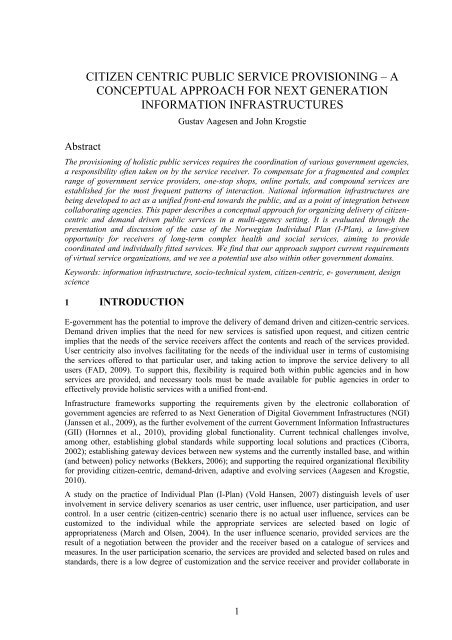Multi-channel provisioning of public services - Department of ...
Multi-channel provisioning of public services - Department of ...
Multi-channel provisioning of public services - Department of ...
Create successful ePaper yourself
Turn your PDF publications into a flip-book with our unique Google optimized e-Paper software.
Abstract<br />
CITIZEN CENTRIC PUBLIC SERVICE PROVISIONING – A<br />
CONCEPTUAL APPROACH FOR NEXT GENERATION<br />
INFORMATION INFRASTRUCTURES<br />
Gustav Aagesen and John Krogstie<br />
The <strong>provisioning</strong> <strong>of</strong> holistic <strong>public</strong> <strong>services</strong> requires the coordination <strong>of</strong> various government agencies,<br />
a responsibility <strong>of</strong>ten taken on by the service receiver. To compensate for a fragmented and complex<br />
range <strong>of</strong> government service providers, one-stop shops, online portals, and compound <strong>services</strong> are<br />
established for the most frequent patterns <strong>of</strong> interaction. National information infrastructures are<br />
being developed to act as a unified front-end towards the <strong>public</strong>, and as a point <strong>of</strong> integration between<br />
collaborating agencies. This paper describes a conceptual approach for organizing delivery <strong>of</strong> citizencentric<br />
and demand driven <strong>public</strong> <strong>services</strong> in a multi-agency setting. It is evaluated through the<br />
presentation and discussion <strong>of</strong> the case <strong>of</strong> the Norwegian Individual Plan (I-Plan), a law-given<br />
opportunity for receivers <strong>of</strong> long-term complex health and social <strong>services</strong>, aiming to provide<br />
coordinated and individually fitted <strong>services</strong>. We find that our approach support current requirements<br />
<strong>of</strong> virtual service organizations, and we see a potential use also within other government domains.<br />
Keywords: information infrastructure, socio-technical system, citizen-centric, e- government, design<br />
science<br />
1 INTRODUCTION<br />
E-government has the potential to improve the delivery <strong>of</strong> demand driven and citizen-centric <strong>services</strong>.<br />
Demand driven implies that the need for new <strong>services</strong> is satisfied upon request, and citizen centric<br />
implies that the needs <strong>of</strong> the service receivers affect the contents and reach <strong>of</strong> the <strong>services</strong> provided.<br />
User centricity also involves facilitating for the needs <strong>of</strong> the individual user in terms <strong>of</strong> customising<br />
the <strong>services</strong> <strong>of</strong>fered to that particular user, and taking action to improve the service delivery to all<br />
users (FAD, 2009). To support this, flexibility is required both within <strong>public</strong> agencies and in how<br />
<strong>services</strong> are provided, and necessary tools must be made available for <strong>public</strong> agencies in order to<br />
effectively provide holistic <strong>services</strong> with a unified front-end.<br />
Infrastructure frameworks supporting the requirements given by the electronic collaboration <strong>of</strong><br />
government agencies are referred to as Next Generation <strong>of</strong> Digital Government Infrastructures (NGI)<br />
(Janssen et al., 2009), as the further evolvement <strong>of</strong> the current Government Information Infrastructures<br />
(GII) (Hornnes et al., 2010), providing global functionality. Current technical challenges involve,<br />
among other, establishing global standards while supporting local solutions and practices (Ciborra,<br />
2002); establishing gateway devices between new systems and the currently installed base, and within<br />
(and between) policy networks (Bekkers, 2006); and supporting the required organizational flexibility<br />
for providing citizen-centric, demand-driven, adaptive and evolving <strong>services</strong> (Aagesen and Krogstie,<br />
2010).<br />
A study on the practice <strong>of</strong> Individual Plan (I-Plan) (Vold Hansen, 2007) distinguish levels <strong>of</strong> user<br />
involvement in service delivery scenarios as user centric, user influence, user participation, and user<br />
control. In a user centric (citizen-centric) scenario there is no actual user influence, <strong>services</strong> can be<br />
customized to the individual while the appropriate <strong>services</strong> are selected based on logic <strong>of</strong><br />
appropriateness (March and Olsen, 2004). In the user influence scenario, provided <strong>services</strong> are the<br />
result <strong>of</strong> a negotiation between the provider and the receiver based on a catalogue <strong>of</strong> <strong>services</strong> and<br />
measures. In the user participation scenario, the <strong>services</strong> are provided and selected based on rules and<br />
standards, there is a low degree <strong>of</strong> customization and the service receiver and provider collaborate in<br />
1
















